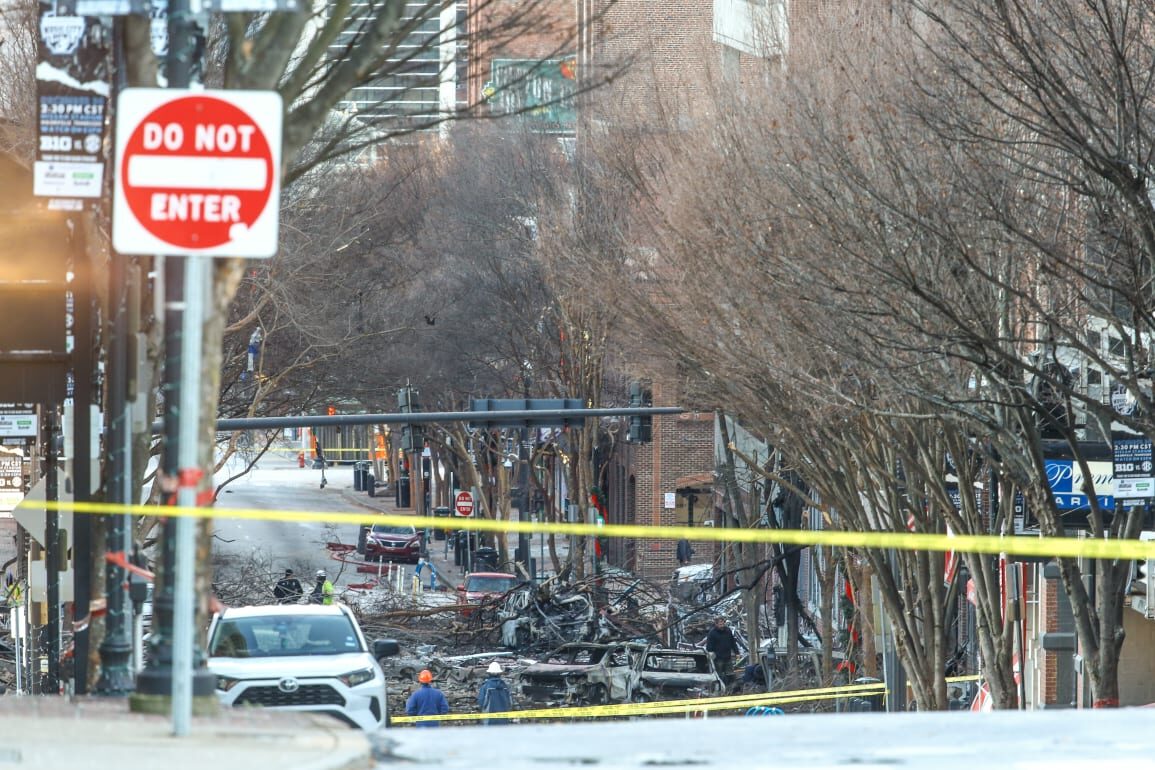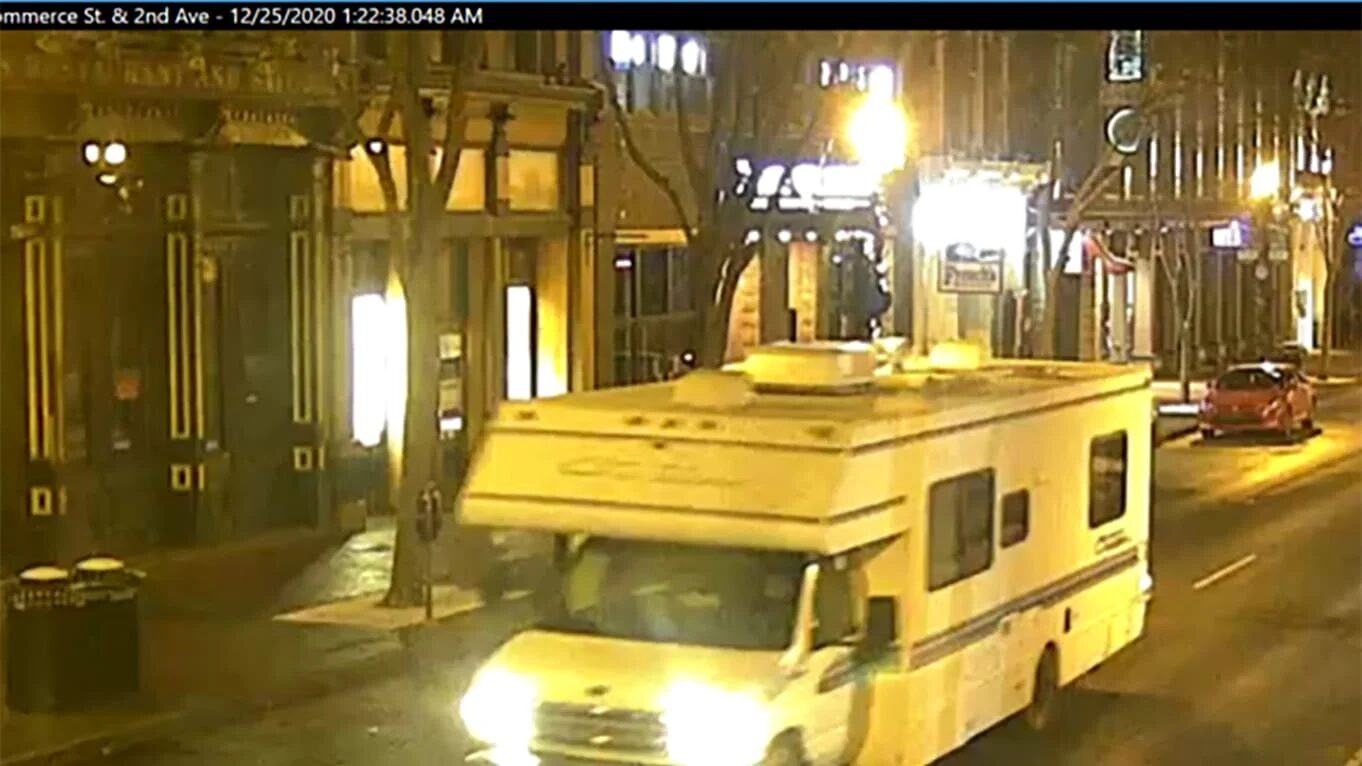Anthony Quinn Warner's device, although probably made of common over-the-counter components, is unique in the annals of mayhem, according to seasoned FBI bomb experts consulted by SpyTalk.
"We've never seen an improvised thermobaric device before in this country or any country," says Dave Williams, who conducted the FBI's on-scene investigations of the World Trade Center, Oklahoma City, Pan Am 103 and Unabomber bombings, among other notorious incidents. Thermobaric refers to a gaseous fuel-air explosion.
"The reason is, it's very difficult to get the timing down to get an optimum mixture of air and a liquified carbonaceous fuel such as propane, methane, acetylene or natural gas," Williams told SpyTalk. "He couldn't have done it the first time and made it work. There had to be a test area."
Accidental thermobaric explosions are not uncommon — for example, when a house explodes because of a natural gas leak. But IED-makers haven't tried to stage them deliberately, up to now, Williams says, because too many things have to go right.
That's why investigators must be eager to locate Warner's proving ground, and also any internet sources he studied as he was building a timer and ignition mechanism that enabled him to blow up a Nashville city block, and himself, at 6:30 a.m. on Christmas Day.
As several news outlets have reported, on Aug. 21, 2019, Warner's ex-girlfriend and her lawyer alerted Nashville police that Warner was "building bombs in the RV trailer" on his property and "frequently talks about the military and bomb-making." The police referred the incident to the FBI, according to the reports, but neither agency obtained a search warrant to investigate the premises. The police report of the charges leveled by the ex-girlfriend and lawyer contains no hint of Warner's evident mastery of bomb-making and related electronics.
Williams' hypothesis, that Warner's RV bomb was likely thermobaric, also known as a fuel-air explosive, aerosol bomb or vacuum bomb, is based on videos of the yellow-orange fireball, the pattern of destruction and conversations with other experts in the tight network of bomb investigators aware of the ongoing investigation in Nashville.
Smokeless firebomb
Significantly, the videos show very little smoke from the bomb itself, which suggests the explosion was very efficient. Black smoke came later, from secondary blazes such as burning tires. To Williams' eye, the videos and photos of wreckage indicate a slow-moving explosion and a type of rolling and heaving also consistent with a relatively slow, homemade device.
At the FBI, where he spent 27 years as a bomb technician, and now, as a consultant on bomb technology, IED countermeasures and structural vulnerabilities, Williams is known for his ability to look at a bombing scene and form a reasonable hypothesis to guide evidence collection and interviews. It's a technique not without controversy: In the 1995 Oklahoma bombing case, a Justice Department Inspector General report criticized Williams' initial assessment as unscientific because, among other things, he offered it before waiting for all the scientific data to come in.
But, as I wrote in my 1998 book, No Heroes - Inside the FBI's Secret Counter-Terror Force (with co-author Danny Coulson, an FBI special agent who led the evidence collection in Oklahoma City), investigators on the ground didn't have the luxury of time to compile the forensic data on explosive residues and fragments. They were racing to find the bomber and possible accomplices who might have been planning more attacks. My own investigation determined that the IG report misstated some facts and that Williams' first-look estimate — that the bomb was roughly 4,000 pounds of ammonium nitrate fertilizer and fuel oil — turned out to be uncannily accurate. FBI agents later got hold of sales records showing that Timothy McVeigh bought exactly 4,000 pounds of ammonium nitrate from a farm co-op in Kansas. McVeigh was eventually convicted of the bombing and executed.

But the mix wouldn't explode by itself. An ignition source would have to have been introduced at precisely the right moment.
A bomber determined to die inside the van might anticipate that he would likely pass out from lack of oxygen before he could detonate the gas with a cigarette lighter. He'd have to set up a device to detonate automatically. It could be as simple as a baggie of black powder, available at hobby shops, wired to an electrical component, for instance, a switch that makes a microwave or dishwasher ding when its cycle is done, or a telephone alarm.
Timing is everything
The trick would be timing the ignition with exquisite precision to detonate the aerosolized gas-air mix at its richest, when it reached maximum destructive power. That moment would depend on the type of gas and altitude.
All this argues for skill, study and hands-on practice through trial and error. The FBI playbook is straightforward: Retrace Warner's steps and build a timeline. Search highway tolls and gasoline purchase via his credit cards. Map out the towers his cellphone pinged as he moved around the countryside. Interview residents near where he stayed and ask about noise, brush fires and other indications of explosive testing. According to Nashville radio station WKRN, quoting law enforcement sources, Warner had spent time in a state park near Nashville, claiming he was hunting "lizard people." If that state park or any other rural area Warner visited has patches of burned-out foliage, the investigators will almost certainly test for residues.
As the crime scene investigators recover components, they should be running a computer search of big box stores, looking for items that were purchased in specific combinations. They should be checking Warner's credit card purchases for such items. If Warner used gas tanks, shards will still be there. At the scene of the World Trade Center bombing in 1993, Williams and his team found the remains of all three hydrogen tanks used to enhance the explosion. (The IED itself was not thermobaric; its explosive core was urea nitrate or nitrourea, apparently homemade.) The FBI will need to interview gas-supply houses for unusual purchases, if it hasn't already.
Other, as yet unidentified substances may have been incorporated into the RV bomb, to trigger or enhance it.
"Unfortunately it is only too easy to build an explosive," says a retired senior FBI agent and bomb expert who asked not to be named because he prefers to stay out of the media spotlight. He spent three decades working on the 1998 U.S. embassy bombings by Al Qaeda in Africa, multiple bombing scenes in the Middle East, the attacks of Sept. 11, 2001, the anthrax attacks and many other cases.
"You need either nitrates or peroxide for the majority of homemade explosives. Both are readily available. Nitrates from fertilizer or even from those instant ice packs you can buy at any pharmacy," he tells SpyTalk. "Those white prills [pellets] inside the packs contain the nitrates. The U.S. government watches suspicious purchases, but if you keep your purchases under certain amounts, no one notices. Also if you have a business (or letterhead!) that purportedly uses that ingredient, then it's easy to escape notice."
"The trick isn't finding something that will go boom," he adds. "It's setting it off. The detonator — a person with electrical skills could easily build one with a little help from the internet. You used to have to find paper manuals, but today it's right online — most with a 'how to' video showing step-by-step guidelines."
This former FBI official finds Williams' theory positing an unprecedented fuel-air IED "very plausible."
Tinker tailored
"We know he 'tinkered' on his RV for a long time so he would be able to easily seal it tight to allow any gas to accumulate," he says. "He had more than enough electrical expertise to construct a timer and initiator that would function when he passed out."
"I think the only way to prove it for sure will be through chemical analysis of any charred remains in the pieces of the RV they recover," he added. "Most RV campers have propane-fueled stoves and heaters, so the mere presence of a propane tank or some trace of propane wouldn't be definitive for a fuel-air device. However, any other type of gas or multiple tanks would be one of the things they are looking for. The visual of the explosion sounds like a fuel-air device, but to confirm it, they will have to do a frame-by-frame examination of all video and a gas chromatography — mass spectrometry analysis of any of the residues."
In the aftermath of the 9/11 attacks, FBI bomb techs played out scenarios that involved fuel-air explosive devices.
"We always worried that someone would attack a hospital with a large truck bomb parked immediately adjacent to a hospital oxygen tank farm," the ex-FBI bomb tech tells SpyTalk.
"Most hospitals have very, very large tank containers of oxygen under pressure stored outside. Most are near the back side of these buildings adjacent to loading dock facilities. Perfect for a large truck bomb to easily access. Most of these tanks are only secured by a chain-link fence and $2 padlock," he says. "When we first began looking into this problem, the majority of these sites didn't even have CCTV coverage and no alarms. A real nightmare scenario."
With all the potentially explosive material on the open market, it's surprising to the bomb tech community that more bombings haven't been attempted.
"We have hundreds, if not thousands of people in this country, who could easily build bombs and have a strong enough grudge, hatred or instability to actually carry out a crime, act of terror or revenge," the former FBI agent says.
"Quite frankly, I am surprised that we don't have more acts of violence like this. I honestly believe that because guns are so readily available, they are the method of choice. Explosives take work, effort and precision. Guns don't, so we have mass shootings instead," he adds. "And let's face it, you can buy guns at Wal-Mart and flea markets and out of newspaper want-ads. There is no problem getting them."
Still, there are some individuals with time on their hands and the necessary obsession, compulsion and talent for precision bomb-making.
Tony Warner, it seems, was one of them.




A lot of the bomb making sites on the internet are ran by the FBI or they would be yanked by the servers. No one operating a server would want the legal liability of hosting a bomb making site.
Targeting the oxygen supplies of a hospital during a pandemic would certainly make a resistance group look like heroes.
Why is the FBI even publicly commenting? Is this the FBI’s way of bragging about the false flag operations that they have already queued up?